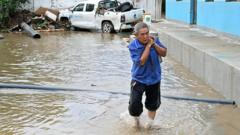The floods have claimed a total of 44 lives across Beijing this summer, which has been marked by extreme weather patterns. Just weeks earlier, eastern regions were sweltering under record heat, while southwest areas experienced severe flooding. Reports indicated that at the time of the floods, around 77 residents were at the nursing home, with approximately 40 individuals trapped as water levels surged to nearly 2 meters (6 feet). Critically, the facility—serving low-income and disabled individuals—was previously deemed in a safe area and thus not included in evacuation plans.
Following the Beijing disaster, nearby Hebei province reported 16 fatalities linked to extreme rainfall and additional losses in neighboring regions highlighted the widespread impact of recent climate events. Beijing is notoriously susceptible to summer flooding, and historical precedents such as the deadly floods of July 2012 emphasize the persistent risks. Additionally, recent natural disasters across China, attributed to climate change, have led to significant economic losses, estimated at 54.11 billion yuan ($7.5 billion) in the first half of the year, primarily due to flooding.
With the stakes rising due to climate volatility, experts stress the need for urgent reforms in disaster management and infrastructure resilience to protect vulnerable populations against the increasing threat of natural disasters.
Following the Beijing disaster, nearby Hebei province reported 16 fatalities linked to extreme rainfall and additional losses in neighboring regions highlighted the widespread impact of recent climate events. Beijing is notoriously susceptible to summer flooding, and historical precedents such as the deadly floods of July 2012 emphasize the persistent risks. Additionally, recent natural disasters across China, attributed to climate change, have led to significant economic losses, estimated at 54.11 billion yuan ($7.5 billion) in the first half of the year, primarily due to flooding.
With the stakes rising due to climate volatility, experts stress the need for urgent reforms in disaster management and infrastructure resilience to protect vulnerable populations against the increasing threat of natural disasters.


















